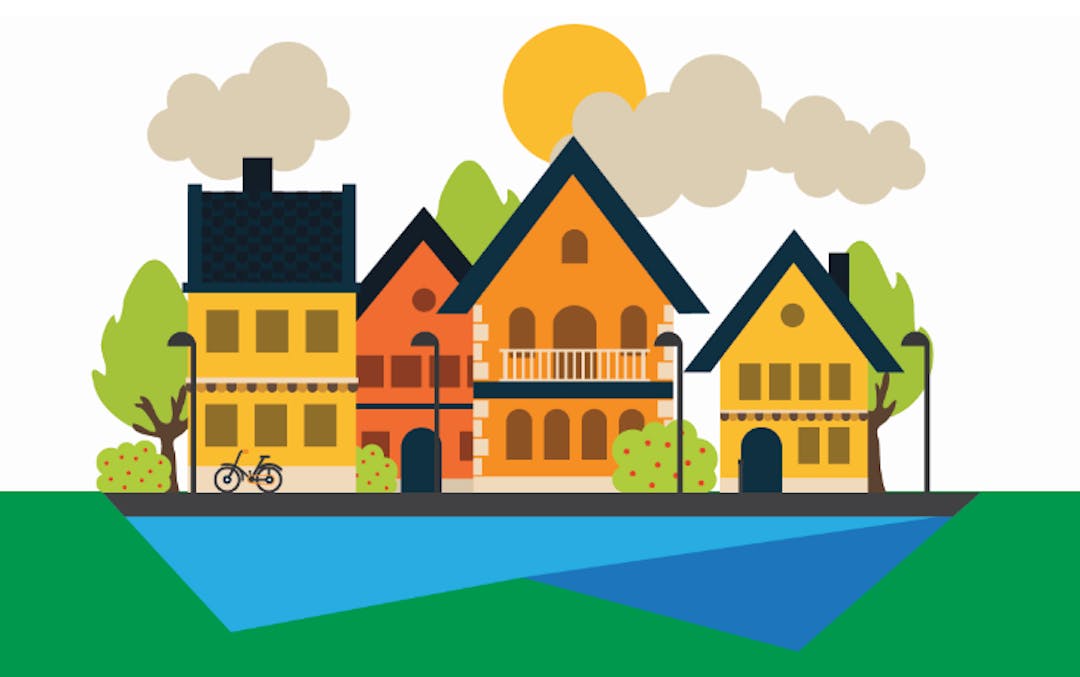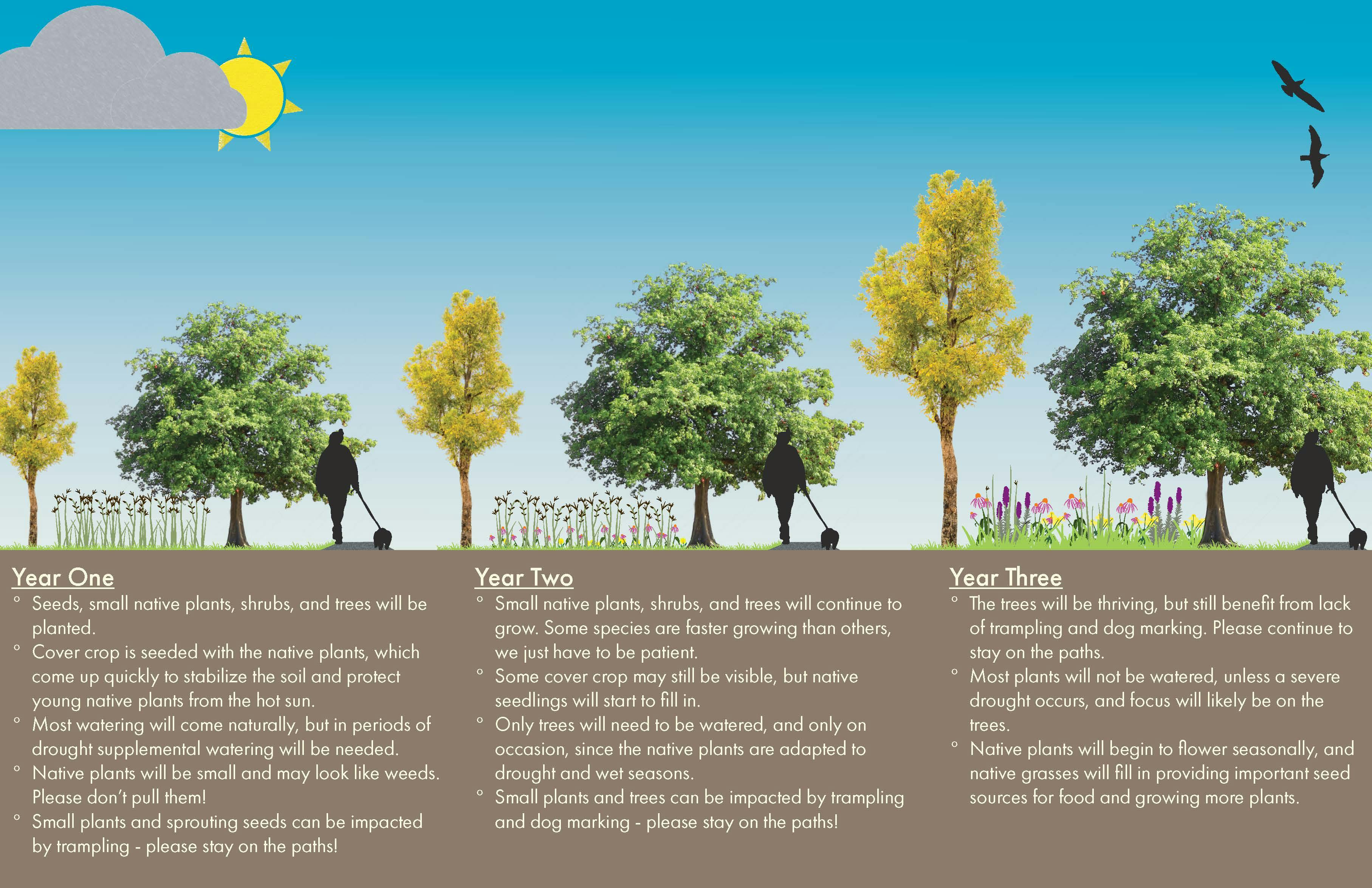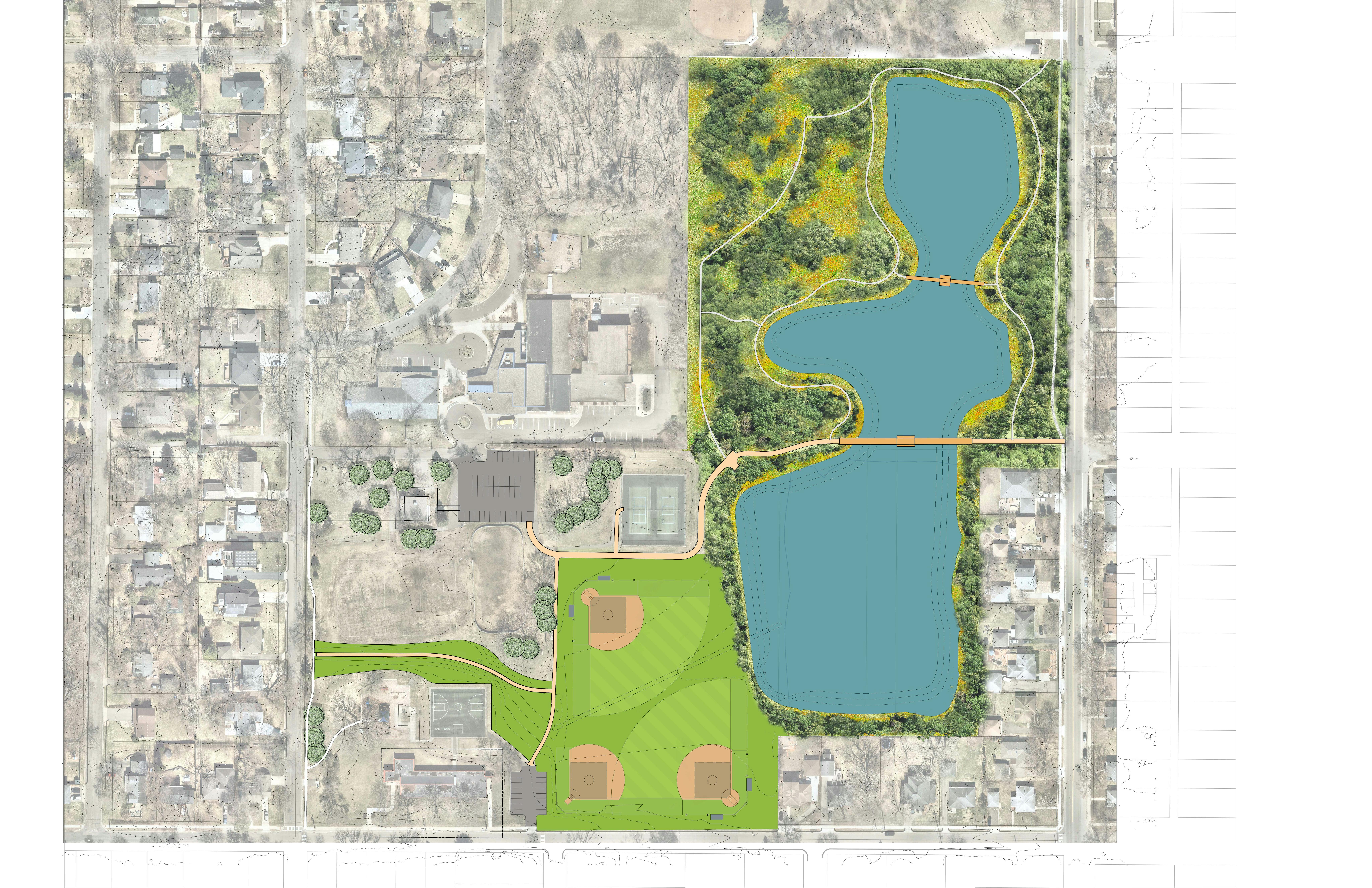Morningside Flood Infrastructure Project
This project has been completed and this project page will no longer be updated. Please contact staff with any questions or comments. Thank you.

The Morningside Neighborhood has several low and landlocked areas prone to flooding. Climate change has already increased the risk of flooding and will continue to do so. This project helps the community be more resilient to flooding. Project benefits are balanced across the neighborhood and there is no increase in risk to any property.
Ponds, pipes and a surface swale will be used to safely move and store floodwaters. An expanded pipe and swale will provide overflow from the Lynn/Kipling inundation area and the Grimes Avenue low point, and an expanded and reconfigured pipe network and minor grade changes will move water away from homes. Weber Pond and the Lynn/Kipling Pond will be expanded and lowered. About six acres of trees will be removed in Weber Woods to accommodate the larger ponds.
The flood infrastructure project also includes:
- Natural resources restoration in upland areas.
- Nature trails and bridge crossings at two locations at Weber Park.
- Improved pedestrian access to the park with some ADA-compliant paths in Weber Park.
- Rebuilt sports fields in impacted areas with new turf and irrigation systems.
The flood infrastructure project coincides with planned roadway reconstruction in the neighborhood in 2022 and 2023.
The Morningside Neighborhood has several low and landlocked areas prone to flooding. Climate change has already increased the risk of flooding and will continue to do so. This project helps the community be more resilient to flooding. Project benefits are balanced across the neighborhood and there is no increase in risk to any property.
Ponds, pipes and a surface swale will be used to safely move and store floodwaters. An expanded pipe and swale will provide overflow from the Lynn/Kipling inundation area and the Grimes Avenue low point, and an expanded and reconfigured pipe network and minor grade changes will move water away from homes. Weber Pond and the Lynn/Kipling Pond will be expanded and lowered. About six acres of trees will be removed in Weber Woods to accommodate the larger ponds.
The flood infrastructure project also includes:
- Natural resources restoration in upland areas.
- Nature trails and bridge crossings at two locations at Weber Park.
- Improved pedestrian access to the park with some ADA-compliant paths in Weber Park.
- Rebuilt sports fields in impacted areas with new turf and irrigation systems.
The flood infrastructure project coincides with planned roadway reconstruction in the neighborhood in 2022 and 2023.
This project has been completed and this project page will no longer be updated. Please contact staff with any questions or comments. Thank you.
-
Decisions decisions
Share Decisions decisions on Facebook Share Decisions decisions on Twitter Share Decisions decisions on Linkedin Email Decisions decisions linkWhat is the decision to be made?
After discussion at the March 16 Council work session, Staff proposes to refine their recommendation and proposes to include the following actions for Council consideration:
1. Affirm design goals, considerations and opportunities.
2. Set maximum capital improvement budget.
3. Affirm strategy of risk transfer with pipe, and mitigation and additional flood reduction with storage.
4. Affirm use of park space in Weber Park, Weber Woods, and Lynn/Kipling inundation area.
5. April City Council action; approve infrastructure design and park landscape architecture scope of service.
Check out the draft preliminary report for more information.
When will a decision be made?
We plan to make a final staff recommendation for the Council to consider at either their April 6th or April 20th meeting.
-
Scale and Balance
Share Scale and Balance on Facebook Share Scale and Balance on Twitter Share Scale and Balance on Linkedin Email Scale and Balance linkAs we tested ideas to manage flood risk in the neighborhood, we learned some lessons about scale and balance.
Infrastructure was sized to provide benefit to all, and harm no one, while balancing flood risk reduction benefits. This requires infrastructure planning on a neighborhood scale, additional flood storage (like expanded ponds), and careful sizing and planning of pipes, flow paths, and intervening flood storage.
Water was only moved downstream when coupled with additional space for it to go. Additional flood storage created by expanding Weber Pond and the open water area between Lynn Ave and Kipling Ave are foundational features of the concept design.
-
Look Whooo was Spotted at Weber Pond
Share Look Whooo was Spotted at Weber Pond on Facebook Share Look Whooo was Spotted at Weber Pond on Twitter Share Look Whooo was Spotted at Weber Pond on Linkedin Email Look Whooo was Spotted at Weber Pond linkCheck out this incredible photo captured by Greg Lincoln yesterday at Weber Pond. We think it's an Eastern Screech Owl.
-
Your feedback influenced the design. And we're still listening.
Share Your feedback influenced the design. And we're still listening. on Facebook Share Your feedback influenced the design. And we're still listening. on Twitter Share Your feedback influenced the design. And we're still listening. on Linkedin Email Your feedback influenced the design. And we're still listening. linkWe are grateful to many individuals that followed, posted, emailed, called, attended and otherwise reached out during this project. Here is a summary of what we heard, and how it affected the design:
- Concerns for individual residential structures
- Concerns for balancing and sharing of benefits throughout neighborhood
- Concerns for future flood risk with climate change
- Concerns about property acquisition or use of public property for flood storage
- Concerns about public spaces and natural resources
- Concerns about floodwall scenarios
- Concerns about some options not serving part of the neighborhood
Here is how public input affected our design
Include as design goals;
- No increase in risk to any individual property
- Balance the risk and benefit of the project
- No private property will be proposed for acquisition
- Avoid floodwalls
Include as design consideration;
- Future climate change
- Limit impact at Weber Park
Take advantage of opportunity;
- Enhance natural areas where impacts occur
- Consider park improvements where impacts occur
- Remove or reduce potential for flood overflow into private property through minor changes in grade
- Add inlets in low areas to fully utilize pipe
Detailed conversations also led the design team to;
- Consider backflow and overflow on Grimes Avenue
- Improve system map and model accuracy in 41st street right-of-way
- Consider overflow on Crocker Avenue
-
Preliminary Recommendation
Share Preliminary Recommendation on Facebook Share Preliminary Recommendation on Twitter Share Preliminary Recommendation on Linkedin Email Preliminary Recommendation linkThe staff and design team are preliminarily recommending creating infrastructure consistent with the “Bigger” option, with the following features to include in design (see Table 1 and Figure 2 of the Tech Memo);
1. An expanded and lowered Weber Pond, (Tech Memo Feature 1) including:
- Expansion into Weber Woods and the removal of approximately 6 acres of trees
- Natural resource restoration and improvement of the entire Weber Woods land area
- Creation of nature trails and a bridge or floating boardwalk connecting east to west across the pond
2. An expanded and lower Lynn/Kipling inundation area (Tech Memo Feature 4) including:
- Tree removal along most of the basin, with several tree stands saved
- A mixed wetland and pond, with aquatic and upland natural resource restoration
3. An expanded pipe and swale to provide overflow from the Lynn/Kipling inundation area (Tech Memo Features 2 and 3) including:
- A box culvert along the 41st right-of-way and easement corridor between homes
- A landscaped swale along the north side of the active play spaces in Weber Park to provide high flow and clean water benefits, including an east to west park trail
4. An expanded and reconfigured pipe network extending west on 42nd, south on Crocker, east on Morningside Road, south on Grimes, and west on Branson (Technical Memo Features 9, 9a, and 10) including:
- Expanded surface inlets to fully utilize pipe capacity in extreme events
- Minor changes to grades in streets and curb lines to reduce potential surface flows or flood backflow into low or landlocked areas
-
City Council Work Session - March 16th
Share City Council Work Session - March 16th on Facebook Share City Council Work Session - March 16th on Twitter Share City Council Work Session - March 16th on Linkedin Email City Council Work Session - March 16th linkWhat is a work session?
A work session is a Council meeting to discuss and consider issues, but no official action or voting occurs. The meeting takes place immediately before the regular City Council meeting. You can view meeting agendas and materials online.
Why is this topic going to a work session meeting?
Staff want to share a preliminary recommendation with City Council to get their feedback and direction. It is an opportunity for Councilmembers to discuss and consider issues together, without any official action or vote.
What questions will be asked of Councilmembers?
- Does the strategy seem sound?
- Do you need more context or policy analysis before deciding?
- What features or opportunities resonate?
- Should we increase focus or add requirements or design goals to any of the features?
- Are there tradeoffs or risk you need to understand better, or are not willing to make?
- Does the recommended level of infrastructure seem reasonable and valuable?
-
Draft Preliminary Report Available
Share Draft Preliminary Report Available on Facebook Share Draft Preliminary Report Available on Twitter Share Draft Preliminary Report Available on Linkedin Email Draft Preliminary Report Available linkStaff will provide a preliminary report for City Councilmembers at a Work Session meeting on March 16th. We've posted a draft preliminary report under the Documents section to give you time to review before we route it to City Councilmembers.
What are the next steps in the process?
- We are eager to hear from you. Please contact us directly with any comments, questions or concerns you have. We'll submit the preliminary report for the City Council Work Session meeting one week prior. If we make any changes to the draft we're sharing today and the version that we submit to City Councilmembers in a couple weeks, we'll describe them for you here.
- At the Work Session meeting, staff will seek direction from City Councilmembers. Check out the draft preliminary report to see what questions we'll ask.
- After the Work Session meeting, staff will make adjustments to the recommendation based on direction provided by City Councilmembers. We'll consider all feedback we hear from you, too.
- Sometime in April, we will ask City Council to make a formal decision. We'll have a better idea of how much time we'll need to incorporate the City Councilmember's direction after the Work Session meeting. We'll let you know within days after the Work Session meeting when we plan to ask City Council to make a formal decision.
- After a decision is made, we'll share it with you here and remain available to help you understand what it means for the neighborhood and the anticipated road reconstruction projects in 2022 and 2023.
-
Technical Memo Available
Share Technical Memo Available on Facebook Share Technical Memo Available on Twitter Share Technical Memo Available on Linkedin Email Technical Memo Available linkThe Technical Memo is available for download.
There is a lot of information in the memo. We'll spend the next several weeks helping you make sense of it and responding to your comments and questions.
Next Steps
We'll use the Technical Memo to form the staff recommendation. We'll preview the staff recommendation with the City Council at their March work session meeting, then ask them to make a decision at a regular meeting in April.
We are eager to hear your reactions to the technical memo. We'll capture your thoughts and consider them as we prepare the staff recommendation.
-
Final Technical Memo - coming soon
Share Final Technical Memo - coming soon on Facebook Share Final Technical Memo - coming soon on Twitter Share Final Technical Memo - coming soon on Linkedin Email Final Technical Memo - coming soon linkWe need a little more time to finalize the Technical Memo. We expect to have it ready within the week. Thank you for your patience!
-
Engagement Report Available
Share Engagement Report Available on Facebook Share Engagement Report Available on Twitter Share Engagement Report Available on Linkedin Email Engagement Report Available linkThe Engagement Report is available for download.
We encourage you to continue providing your feedback as we prepare the staff recommendation for Council to consider in March and April. We'll capture your reactions and ideas in our staff report.
Who's Listening
-
Phone 952-903-5713 Email RBintner@EdinaMN.gov -
Phone 952-826-0445 Email JWilson@EdinaMN.gov -
Phone 952-826-0317 Email TSwenson@EdinaMN.gov
Key Dates
-
July 11 2024
-
October 19 2021
-
September 21 2021
Photos
Lifecycle
-
Share Information
Morningside Flood Infrastructure Project has finished this stageSummer 2020
Information about flood risk, Edina's Flood Risk Reduction Strategy, and actions people can take to reduce their own flood risk will be shared.
-
Present Initial Concepts
Morningside Flood Infrastructure Project has finished this stageFall 2020
Initial concepts will be presented for feedback.
-
Present Refined Concepts
Morningside Flood Infrastructure Project has finished this stageWinter 2020
Refined concepts based on feedback will be presented.
-
Make a Decision
Morningside Flood Infrastructure Project has finished this stageSpring 2021
Staff will make a recommendation and City Council will make a decision.
-
Close the Loop - Concept Design Phase
Morningside Flood Infrastructure Project has finished this stageSpring 2021
The decision will be communicated to the public and archived on the Better Together Edina project page.
-
Added: Detailed Engineering and Landscape Design Begins
Morningside Flood Infrastructure Project has finished this stageSpring 2021
City Council approved the project at their April 20th, 2021 meeting. This moved the project from the concept design phase to the detailed engineering and landscape design phase.
-
Added: Present Landscape Design
Morningside Flood Infrastructure Project has finished this stageSummer 2021
An initial version of the design (at 30% completion) will be presented for feedback.
-
Added: Make a Decision
Morningside Flood Infrastructure Project has finished this stageFall 2021
Staff will make a recommendation and City Council will make a decision.
-
Added: Design
Morningside Flood Infrastructure Project has finished this stageFall 2021 - Winter 2022
Staff will complete the design and prepare construction bid documents.
-
Added: Construction Phase 1
Morningside Flood Infrastructure Project has finished this stageWinter 2022
Tree removal.
-
Added: Construction Phase 2
Morningside Flood Infrastructure Project has finished this stageSpring 2022 - early Winter 2023
Grading and excavation to create flood storage.
Upstream pipe capacity work will occur as part of the street reconstruction projects in 2022 and 2023.
-
Added: Construction Phase 3 - Park Restoration
Morningside Flood Infrastructure Project is currently at this stageFall 2022 - Summer 2023
Turf restoration, natural resource restoration, and tree planting.
Related projects
Documents
-
 MFIP_Outcomes_How it works.pdf (9.18 MB) (pdf)
MFIP_Outcomes_How it works.pdf (9.18 MB) (pdf)
-
 MFIP_Outcomes_Boards.pdf (10.1 MB) (pdf)
MFIP_Outcomes_Boards.pdf (10.1 MB) (pdf)
-
 Weber Park Scavenger Hunt Map.pdf (2.71 MB) (pdf)
Weber Park Scavenger Hunt Map.pdf (2.71 MB) (pdf)
-
 Restoration Phase Graphic.pdf (5.39 MB) (pdf)
Restoration Phase Graphic.pdf (5.39 MB) (pdf)
-
 2022_Morningside-Flood-Infrastructure_FAQs.pdf (353 KB) (pdf)
2022_Morningside-Flood-Infrastructure_FAQs.pdf (353 KB) (pdf)
-
 Final park plan_Feb2022.pdf (6.81 MB) (pdf)
Final park plan_Feb2022.pdf (6.81 MB) (pdf)
-
 Park Birds Eye View Feb2022.pdf (2.53 MB) (pdf)
Park Birds Eye View Feb2022.pdf (2.53 MB) (pdf)
-
 Pond boardwalk rendering Feb2022.pdf (1.75 MB) (pdf)
Pond boardwalk rendering Feb2022.pdf (1.75 MB) (pdf)
-
 Lynn Kipling Pond Plan_Feb2022.pdf (2.8 MB) (pdf)
Lynn Kipling Pond Plan_Feb2022.pdf (2.8 MB) (pdf)
-
 Edition Edina_Feb2022.pdf (1.95 MB) (pdf)
Edition Edina_Feb2022.pdf (1.95 MB) (pdf)
-
 Ecological Quality Assessment Report_2021.pdf (1.68 MB) (pdf)
Ecological Quality Assessment Report_2021.pdf (1.68 MB) (pdf)
-
 Morningside_Habitat_Plan.pdf (6.27 MB) (pdf)
Morningside_Habitat_Plan.pdf (6.27 MB) (pdf)
-
 maps
maps
-
 concept development
concept development
-
 Edina's Flood Risk Reduction Strategy report (21.6 MB) (pdf)
Edina's Flood Risk Reduction Strategy report (21.6 MB) (pdf)
-
 Public Participation Plan (177 KB) (pdf)
Public Participation Plan (177 KB) (pdf)
-
 Anticipated Project Timeline - as of June 3, 2020 (2.33 MB) (jpg)
Anticipated Project Timeline - as of June 3, 2020 (2.33 MB) (jpg)
-
 June 3, 2020 presentation (2.33 MB) (pdf)
June 3, 2020 presentation (2.33 MB) (pdf)
-
 Survey 1 results.jpg (98.5 KB) (jpg)
Survey 1 results.jpg (98.5 KB) (jpg)
-
 September 3, 2020 presentation (10.4 MB) (pdf)
September 3, 2020 presentation (10.4 MB) (pdf)
-
 Morningside_Flood_Infrastructure_Technical_Memo_Oct2020.pdf (10.7 MB) (pdf)
Morningside_Flood_Infrastructure_Technical_Memo_Oct2020.pdf (10.7 MB) (pdf)
-
 Infrastructure Scenarios_Oct2020.pdf (12.4 MB) (pdf)
Infrastructure Scenarios_Oct2020.pdf (12.4 MB) (pdf)
-
 December 9, 2020 presentation (3.2 MB) (pdf)
December 9, 2020 presentation (3.2 MB) (pdf)
-
 Engagement Report_January 2021 (17.3 MB) (pdf)
Engagement Report_January 2021 (17.3 MB) (pdf)
-
 Technical_Memo_Feb2021.pdf (7.04 MB) (pdf)
Technical_Memo_Feb2021.pdf (7.04 MB) (pdf)
-
 DRAFT Preliminary Report_March 16 Work Session.pdf (1.92 MB) (pdf)
DRAFT Preliminary Report_March 16 Work Session.pdf (1.92 MB) (pdf)
-
 FINALIZED Preliminary Report_March 16 Work Session.pdf (1.79 MB) (pdf)
FINALIZED Preliminary Report_March 16 Work Session.pdf (1.79 MB) (pdf)
-
 Staff Report_April 20 2021 (793 KB) (pdf)
Staff Report_April 20 2021 (793 KB) (pdf)
-
-
 30% design
30% design
-
 Eng&Landscape Design Public Participation Plan (167 KB) (pdf)
Eng&Landscape Design Public Participation Plan (167 KB) (pdf)
-
 Morningside 30%Plan.pdf (4.82 MB) (pdf)
Morningside 30%Plan.pdf (4.82 MB) (pdf)
-
 Morningside 30%Imagery.pdf (5.35 MB) (pdf)
Morningside 30%Imagery.pdf (5.35 MB) (pdf)
-
 Morningside 30%Timeline_LK.pdf (3.71 MB) (pdf)
Morningside 30%Timeline_LK.pdf (3.71 MB) (pdf)
-
 Sept 21, 2021 City Council Presentation.pdf (6.1 MB) (pdf)
Sept 21, 2021 City Council Presentation.pdf (6.1 MB) (pdf)
-
 Sept 21, 2021 Staff Report.pdf (318 KB) (pdf)
Sept 21, 2021 Staff Report.pdf (318 KB) (pdf)
-
 Revised Morningside 30%Plan.pdf (13.7 MB) (pdf)
Revised Morningside 30%Plan.pdf (13.7 MB) (pdf)
-
 Stakeholder Engagement Report_Oct2021 (610 KB) (pdf)
Stakeholder Engagement Report_Oct2021 (610 KB) (pdf)
-
 Stakeholder Engagement Report_Appendix (1.63 MB) (pdf)
Stakeholder Engagement Report_Appendix (1.63 MB) (pdf)
-
Videos
-
Click here to play video Weber Park Ribbon Cutting Reel Weber Park Ribbon Cutting Ceremony, July 11 , 2024
-
 Click here to play video
Morningside Project (starts at 3 min mark) 30% approval summary
Morningside Project (starts at 3 min mark) 30% approval summary
Click here to play video
Morningside Project (starts at 3 min mark) 30% approval summary
Morningside Project (starts at 3 min mark) 30% approval summary
-
 Click here to play video
Flood Risk in the Morningside Neighborhood - a closer look
A closer look at the flooding problems in the Morningside Neighborhood.
Click here to play video
Flood Risk in the Morningside Neighborhood - a closer look
A closer look at the flooding problems in the Morningside Neighborhood.
-
 Click here to play video
Flood Risk in the Morningside Neighborhood
An overview of how and where flooding happens.
Click here to play video
Flood Risk in the Morningside Neighborhood
An overview of how and where flooding happens.

















